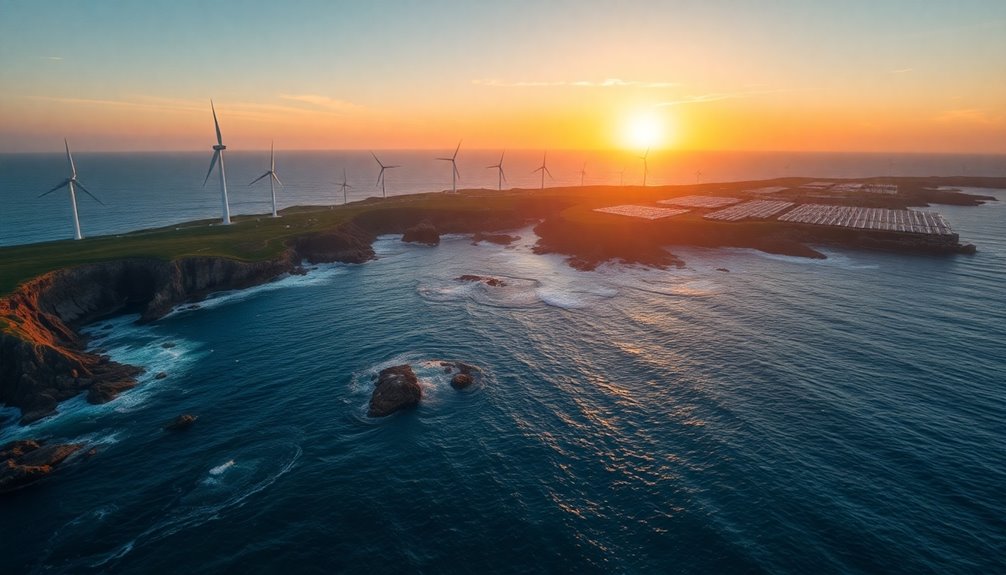If you're exploring the best spots for ocean energy production, look no further than Florida and South Africa. These regions boast high power densities, making them prime candidates for harnessing ocean currents. Eastern Africa, including Somalia and Kenya, also shows promise. You'll find that shallow waters ease turbine deployment, while deeper areas present unique challenges. Curious about the latest developments and innovations in ocean energy? Continue and discover more about this exciting renewable resource.
Key Takeaways
- Florida and South Africa are prime regions for ocean current energy with high power densities along their coasts.
- Eastern Africa, including Somalia, Kenya, and Tanzania, shows significant potential for ocean energy production.
- Approximately 75% of high-power ocean regions have densities between 500 to 1,000 watts per square meter.
- China leads globally in tidal stream capacity, with major projects already operational.
- The U.S. government actively supports marine energy development through substantial funding and incentives.

The vast expanse of the world's oceans, which cover over 70% of the Earth's surface, presents an incredible opportunity for clean energy production through ocean currents and waves. As global demand for energy grows, traditional sources face increasing strain, making the shift to renewable alternatives like ocean energy essential.
The world's oceans hold immense potential for clean energy, crucial for a sustainable future amidst rising global energy demands.
Though marine renewable energy is still in the early stages of development compared to wind and solar power, recent studies are shedding light on its immense global potential. Regions like Florida and South Africa stand out as prime locations for ocean current energy production. These areas boast high power densities, particularly along the Southeast U.S. coast, stretching from Florida to North Carolina. High power densities consistently found off Florida's East coast and South Africa indicate the viability of harnessing ocean energy in these regions.
Eastern Africa, including Somalia, Kenya, Tanzania, and Madagascar, also shows significant promise. About 75% of these high-power regions have densities ranging from 500 to 1,000 watts per square meter, with approximately 490,000 square kilometers of ocean deemed suitable for moderate power production.
You'll find that shallow waters enhance turbine deployment in spots like Florida and South Africa, while deeper waters present challenges for installation and stability. Advanced mooring systems are required to ensure turbine stability in those deeper environments, and increased depth raises concerns about installation and maintenance costs.
As technology evolves, specialized innovations are emerging to address these challenges. Seasonal variations also play a role in energy availability. For instance, higher power densities are observed in the Northern Hemisphere during warmer months, especially in Florida and Japan, while South Africa experiences peaks during its warmer season.
Reliable estimates in North America and Japan stem from extensive data, but areas like South Africa and Brazil struggle due to limited information and variable conditions. Looking ahead, global activity in ocean energy is ramping up, especially outside Europe.
China leads in tidal stream capacity, with significant projects underway, while Canada showcases a promising market with its demonstration projects. The U.S. is also stepping up, with the Biden administration supporting marine energy development through substantial funding.
Frequently Asked Questions
What Technologies Are Used for Ocean Energy Production?
When it comes to ocean energy production, you'll encounter several key technologies.
Tidal barrages convert gravitational energy from tidal movements into electricity, offering predictable output.
For wave energy, mechanical devices like oscillating water columns harness energy from sea waves, though their output can be intermittent.
Additionally, ocean thermal energy conversion (OTEC) utilizes temperature differences in water for a steady energy supply.
Each technology presents unique advantages and challenges for harnessing ocean energy effectively.
How Does Ocean Energy Impact Marine Ecosystems?
Think of ocean energy as a double-edged sword. While it can provide clean energy, it also threatens marine ecosystems.
You'll find that energy devices can disrupt habitats, alter animal behaviors, and even lead to collisions with marine life. Additionally, noise pollution from these technologies can affect communication among species.
To protect biodiversity, it's crucial you advocate for proper monitoring and impact assessments as ocean energy develops, ensuring sustainability and environmental balance.
What Are the Costs Associated With Ocean Energy Projects?
When considering ocean energy projects, you'll face various costs. High capital expenditures come from developing and deploying technology, while operating expenses soar due to challenging marine conditions.
The levelized cost of energy (LCOE) often remains high compared to other renewables. To reduce these costs, focus on technological advancements, streamlined supply chains, and government support.
How Reliable Is Ocean Energy Compared to Other Renewables?
Did you know ocean energy could potentially supply 57% of U.S. power generation if fully harnessed?
In terms of reliability, ocean energy stands out. Unlike solar and wind, ocean currents and tides are predictable and consistent, offering a stable energy source.
While challenges like high installation costs exist, the potential for continuous electricity generation makes ocean energy a promising option compared to other renewables.
You'll find its reliability hard to overlook.
What Is the Future Potential of Ocean Energy Globally?
The future potential of ocean energy globally is immense. By 2050, it could reach up to 350 GW, significantly aiding decarbonization efforts.
With oceans covering over 70% of the Earth's surface, you've got a vast renewable resource at your fingertips. Ocean energy's predictability provides clean, local electricity, beneficial for coastal regions.
Conclusion
As you explore these remarkable locations for ocean energy production, envision a world where the tides don't just ebb and flow but dance gracefully to the rhythm of innovation. Each site represents a beacon of hope, harnessing the ocean's gentle whispers to power our future. Embrace the promise of sustainable energy, where the waves cradle our dreams and transform them into reality. Together, let's ride this wave toward a cleaner, greener planet for generations to come.









